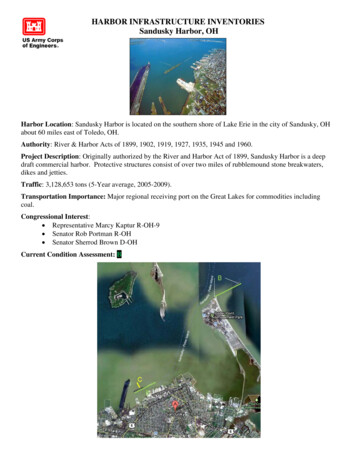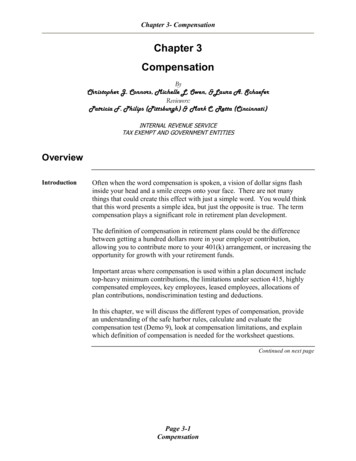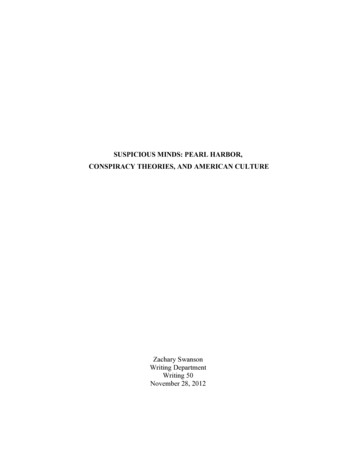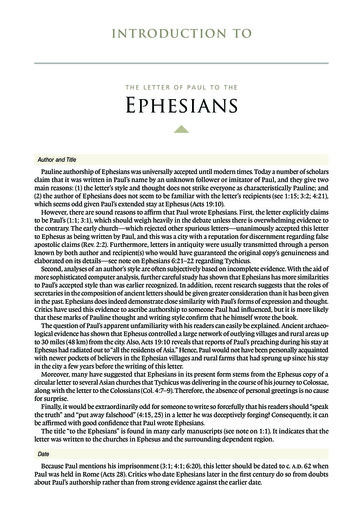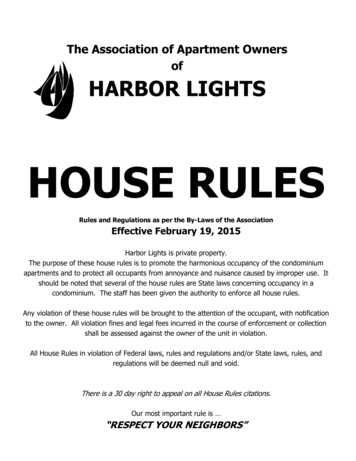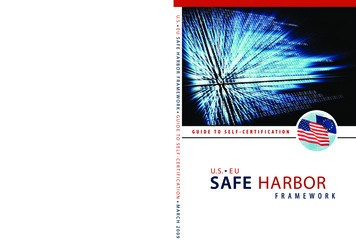
Transcription
U. S. E U S A F E H A R B O R F R A M E W O R K G U I D E T O S E L F - C E R T I F I C AT I O N Fax: 202.482.5522 www.export.gov/safeharborMARCH 2009Telephone: 202.482.5023 U.S. Department of CommerceU.S.-EU Safe Harbor Framework1401 Constitution Avenue, N.W.Room 2003Washington, DC 20230
U.S.- EU Safe Harbor FrameworkA Guide to Self-Certification
Table of ContentsIntroduction. . . . . . . . . . . . . . . . . . . . . . . . . . . . . . . . . . . . . . . . . . . . . . . . . . . . . . . 1Overview. . . . . . . . . . . . . . . . . . . . . . . . . . . . . . . . . . . . . . . . . . . . . . . . . . . . . . . . . . 3Helpful Hints Guide . . . . . . . . . . . . . . . . . . . . . . . . . . . . . . . . . . . . . . . . . . . . . . . . 7Safe Harbor Privacy Principles . . . . . . . . . . . . . . . . . . . . . . . . . . . . . . . . . . . . . 10Frequently Asked Questions (FAQs) . . . . . . . . . . . . . . . . . . . . . . . . . . . . . . . . . 15AppendicesSafe Harbor Application . . . . . . . . . . . . . . . . . . . . . . . . . . . . . . . . . . . . . . . 37Sample Privacy Policies. . . . . . . . . . . . . . . . . . . . . . . . . . . . . . . . . . . . . . . . 41Dispute Resolution Providers . . . . . . . . . . . . . . . . . . . . . . . . . . . . . . . . . . 49U.S.-Swiss Safe Harbor Framework. . . . . . . . . . . . . . . . . . . . . . . . . . . . . . 53Certification Marka. Description. . . . . . . . . . . . . . . . . . . . . . . . . . . . . . . . . . . . . . . . . . . . . 54b. Instructions for Use. . . . . . . . . . . . . . . . . . . . . . . . . . . . . . . . . . . . . 54Glossary . . . . . . . . . . . . . . . . . . . . . . . . . . . . . . . . . . . . . . . . . . . . . . . . . . . . . . 56
IntroductionWelcome to the U.S.-European Union (EU) Safe Harbor Framework: A Guide toCertification. From this guide, it is our hope that U.S. companies will have a better understanding of the process of self-certification and the resources availableto self-certify compliance with the EU’s Directive on Data Protection. Additionalinformation may be found on our website: http://export.gov/safeharbor/In this guide, we have provided an outline of the most critical pieces of the SafeHarbor Framework. The application is made available, along with a Helpful HintsGuide that explains how to fill it out. The Safe Harbor Principles and FAQs arealso provided for easy reference. There is also an explanation and listing of thirdparty dispute resolution providers (or Independent Resource Mechanisms) withdescriptions of the services provided by three dispute resolution providers thatwork with Safe Harbor. Finally, we’ve also included several sample companyprivacy policies for reference, and a glossary that explains key terms. We’ve broken this Guide into nine major sections, each to address different questions youmight have. What follows is a brief description of each section:Overview: The overview gives some background on the Safe Harbor Framework,how it came about, and explains many of the certification requirements. Theoverview also lists the principles of the Safe Harbor program.Application: The Application is provided for easy reference. Applicants shouldapply online at http://export.gov/safeharbor (click on “Certification Form” inthe right sidebar).Certification Mark: The Commerce Department’s International Trade Administration has recently developed a certification mark for the Safe Harbor Framework. The mark may be used by companies on their websites to signify thatthey have self-certified compliance with the provisions of the Safe HarborFramework. Instructions for use of the certification mark are provided.Helpful Hints Guide (to Certification): The Helpful Hints Guide is meant togive quick answers to any questions a U.S. company might have about thecertification process. It should be used in conjunction with the rest of theGuide, however it answers many of the most common questions about thecertification process.Safe Harbor Principles: We have provided the full text of the official declarationof the Safe Harbor Principles as announced on July 21, 2000. This text ishelpful for understanding the foundation of the Safe Harbor Principles and theFramework.1
Frequently Asked Questions: We have provided the Frequently Asked Questionsin full text because they answer many of the most commonly asked questionsabout the Safe Harbor Framework.Safe Harbor OverviewDispute Resolution Providers: Here we have provided a short description of therole of dispute resolution providers (also referred to as Independent RecourseMechanisms) and descriptions of the services they offer.When the European Commission’s Directive on Data Protection went into effect in October of 1998, one consequence was to prohibit the transfer of personal data to non-European Union nations that failed to meet the European“adequacy” standard for privacy protection. While the United States and theEuropean Union share the goal of enhancing privacy protection for their citizens, the United States takes a different approach to privacy than that takenby the European Union. To bridge these different privacy approaches andprovide a streamlined and cost-effective means for U.S. organizations to satisfy the adequacy requirement of the Directive, the U.S. Department of Commerce in consultation with the European Commission (EC) developed a “SafeHarbor” framework and a website to provide the information an organizationwould need to evaluate – and then join – the Safe Harbor.Sample Privacy Policies: Here we have provided three sample privacy policiesfor reference, which may serve as guidance when creating a new PrivacyPolicy or updating an existing Privacy Policy to align it with the Safe HarborFramework. The Safe Harbor Framework requires an affirmative commitmentin the Privacy Policy to the principles of the Safe Harbor Framework.Glossary: A short glossary is also provided for many of the technical termsfrequently used in the Guide.Background on the Safe HarborApproved by the EC in 2000, the Safe Harbor Framework helps protect U.S.companies from experiencing interruptions in their business dealings with theEU. Self-certifying to the Safe Harbor will assure that EU organizations knowthat your company provides “adequate” privacy protection, as defined by theEU Directive.Safe Harbor BenefitsThe Safe Harbor Framework provides a number of important benefits to U.S.and EU firms. Benefits for U.S. organizations participating in the Safe Harborinclude: A ll 27 Member States of the European Union will be bound by the EuropeanCommission’s finding of adequacy;C ompanies participating in the Safe Harbor will be deemed adequate anddata flows to those companies will continue;M ember State requirements for prior approval of data transfers either willbe waived or approval will be automatically granted; andClaims brought by European citizens against U.S. companies will be heardin the United States subject to limited exceptions.The Safe Harbor Framework offers a simpler and cheaper means of complyingwith the adequacy requirements of the Directive, which should particularlybenefit small and medium-sized enterprises.2The U.S.–EU Safe Harbor Guide to Self-CertificationU.S. Department of Commerce3
An EU organization can ensure that it is sending information to a U.S. organization participating in the Safe Harbor by viewing the public list of Safe Harbor organizations posted on the Safe Harbor website: http://export.gov/safeharbor/(click on “Safe Harbor List” in the right sidebar). This list contains the names ofall U.S. companies that have self-certified to the Safe Harbor Framework. Thislist is updated regularly.How does an organization join?The decision by U.S. organizations to enter the Safe Harbor is entirely voluntary. Organizations that decide to participate in the Safe Harbor must complywith the Safe Harbor’s requirements and publicly declare that they do so. Tobe assured of Safe Harbor benefits, an organization needs to self-certify annually to the Department of Commerce in writing that it agrees to adhere to theSafe Harbor’s requirements, which include elements such as notice, choice,access, and enforcement. It must also state in its published privacy policystatement that it adheres to the Safe Harbor. The Department of Commercewill maintain a list of all organizations that file self-certification letters andmake both the list and the self-certification letters publicly available.To qualify for the Safe Harbor, an organization can (1) join a self-regulatory privacy program that adheres to the Safe Harbor’s requirements; or (2) develop itsown self-regulatory privacy policy that conforms to the Safe Harbor. Further,the organization must be subject to the jurisdiction either of the Federal TradeCommission (FTC) or, with respect to air carriers and ticket agents, the Department of Transportation (DOT). The FTC and DOT have authority to take enforcement action against organizations that state they are in compliance with theSafe Harbor framework but then fail to live up to their statements. Organizations currently ineligible for Safe Harbor include financial institutions, includingbanks, investment houses, credit unions, savings & loan institutions, non-profitorganizations, insurances companies and meat processing facilities.What do the Safe Harbor principles require?Organizations must comply with the seven Safe Harbor principles. The principles require the following:1. NoticeOrganizations must notify individuals about the purposes for which they collect and use information about them. They must provide information abouthow individuals can contact the organization with any inquiries or complaints,the types of third parties to which they disclose the information and thechoices and means the organization offers for limiting its use and disclosure.4The U.S.–EU Safe Harbor Guide to Self-Certification2. ChoiceOrganizations must give individuals the opportunity to choose (opt out)whether their personal information will be disclosed to a third party or usedfor a purpose incompatible with the purpose for which it was originally collected or subsequently authorized by the individual. For sensitive information, affirmative or explicit (opt in) choice must be given if the information isto be disclosed to a third party or used for a purpose other than its originalpurpose or the purpose authorized subsequently by the individual.3. Onward Transfer (Transfers to Third Parties)To disclose information to a third party, organizations must apply the noticeand choice principles. Where an organization wishes to transfer informationto a third party that is acting as an agent, it may do so if it makes sure thatthe third party subscribes to the Safe Harbor principles or is subject to theDirective or another adequacy finding. As an alternative, the organization canenter into a written agreement with such third party requiring that the thirdparty provide at least the same level of privacy protection as is required bythe relevant principles.4. AccessIndividuals must have access to personal information about themselves thatan organization holds and be able to correct, amend, or delete that information where it is inaccurate, except where the burden or expense of providingaccess would be disproportionate to the risks to the individual’s privacy inthe case in question, or where the rights of persons other than the individualwould be violated.5. SecurityOrganizations must take reasonable precautions to protect personal information from loss, misuse and unauthorized access, disclosure, alteration and destruction.6. Data integrityPersonal information must be relevant for the purposes for which it is to beused. An organization should take reasonable steps to ensure that data is reliable for its intended use, accurate, complete, and current.7. EnforcementIn order to ensure compliance with the Safe Harbor principles, there mustbe (a) readily available and affordable independent recourse mechanismsso that each individual’s complaints and disputes can be investigated andU.S. Department of Commerce5
resolved and damages awarded where the applicable law or private sectorinitiatives so provide; (b) procedures for verifying that the commitments companies make to adhere to the Safe Harbor principles have been implemented; and (c) obligations to remedy problems arising out of a failure to complywith the principles. Sanctions must be sufficiently rigorous to ensure compliance by the organization. Organizations that fail to provide annual self-certification letters will no longer appear in the list of participants and Safe-Harborbenefits will no longer be assured.To provide further guidance, the Department of Commerce has issued a set offrequently asked questions and answers (FAQs) that clarify and supplementthe Safe Harbor principles which can be found in Appendix C or online at:http://export.gov/safeharbor/SH Documents.aspFor an overview, please visit:http://www.export.gov/safeharbor/SH Overview.aspHelpful Hints GuideThis section contains a succinct guide to assist you with the self-certificationprocess for Safe Harbor. It functions as a checklist of questions and a to-dolist to help determine your firm’s readiness to begin the certification process.Topics include considering whether your firm falls under the jurisdiction of theU.S. Federal Trade Commission or Department of Transportation; developinga Safe Harbor compliant privacy policy statement; establishing your organization’s independent recourse mechanism, and ensuring it is in place; and designating a contact point within your organization regarding Safe Harbor. Thissection should be used in conjunction with the rest of the Guide, and the requirements for self-certification detailed in #6, of the FAQs; however it answersmany common questions surrounding the certification process.Helpful Hints Prior to Self-Certifying to the Safe Harbor1. Confirm That Your Organization is subject to the Jurisdiction of Either the U.S.Federal Trade Commission of the U.S. Department of Transportation:Any U.S. organization that is subject to the jurisdiction of the Federal TradeCommission (FTC) or U.S. air carriers and ticket agents subject to the jurisdiction of the Department of Transportation (DoT) may participate in theSafe Harbor. The FTC and DoT have both stated in letters to the EuropeanCommission (located under http://export.gov/safeharbor/SH Documents.asp Letters G & H) that they can take enforcement action against organizations that state that they are in compliance with the Safe Harbor, but thenfail to live up to their statements. If you are uncertain as to whether yourorganization falls under the jurisdiction of either the FTC or DoT, be sure tocontact those agencies for more information.2. Develop a Safe Harbor Compliant Privacy Policy Statement:Remember to develop a Safe Harbor compliant privacy policy statement before submitting a self-certification form to the Department of Commerce. 6The U.S.–EU Safe Harbor Guide to Self-Certification Make Sure That Your Privacy Policy Statement Conforms to the Safe HarborPrinciples: In order for a privacy policy to be compliant with the SafeHarbor, the privacy policy statement must conform to the seven PrivacyPrinciples and any relevant points that are covered in the Frequently AskedQuestions (FAQs) - located in Appendix C or online at: http://export.gov/safeharbor/SH Documents.asp. In addition, the privacy policy statementshould reflect your actual and anticipated information handling practices.It is also important to write a policy that is clear, concise and easy tounderstand.U.S. Department of Commerce7
M ake Specific Reference to Your Organization’s Safe Harbor Adherence in theText of Your Organization’s Privacy Policy: FAQ 6 requires all organizationsthat self-certify to state in their relevant published privacy policystatements that they adhere to the Safe Harbor Principles (Appendix B).P rovide an Accurate Privacy Policy Statement Location and Make Sure thatYour Privacy Policy Statement is Available to the Public:At the time of self-certification, all organizations must provide an accurateand publicly available location for their applicable privacy statement. If yourorganization decides to post its privacy policy statement on an Internet or Intranet site, it must provide an accurate link to the statement on the organization’s Safe Harbor self-certification form. In addition, the organization shouldverify that its privacy policy statement is effective prior to self-certification.3. Establish Your Organization’s Independent Recourse Mechanism: Under theSafe Harbor’s Enforcement Principle, organizations self-certifying to SafeHarbor must establish an independent recourse mechanism availableto investigate unresolved complaints. (See FAQ 11 for more informationregarding dispute resolution under Safe Harbor.) The organization mustensure that its recourse mechanism is in place prior to self-certification. 8In most cases, organizations self-certifying to Safe Harbor may chooseto utilize private sector dispute resolution programs. While programsvary, organizations like BBB OnLine, TRUSTe, AICPA WebTrust, the DirectMarketing Association, the Entertainment Software Rating Board, JAMS andthe American Arbitration Association have developed programs that assistin compliance with the Safe Harbor’s enforcement principle and FAQ 11.Alternatively, organizations may choose to cooperate and complywith the European Data Protection Authorities (DPAs). In doing so, theorganization must follow the procedures outlined in FAQ 5. If humanresources data is being covered in the organization’s self-certification,the organization must agree to cooperate and comply with the DPAs forpurposes of handling unresolved complaints. Additional guidance forthe handling of human resources data under the Safe Harbor is providedin FAQ 9.Council for International Business (c/o Mr. Paul Cronin, U.S. Council forInternational Business (USCIB); 1212 Avenue of the Americas; New York, NY10036), which has agreed to act as trusted third party for this purpose. Please see FAQ 5 for more details regarding the role of the Data ProtectionAuthorities. Should you need further information on how to carry out thepayment, please contact Mr. Paul Cronin, USCIB, at 212-703-5088, or pcronin@uscib.org. If, on the other hand, you require more information on how thecooperation/compliance with the EU DPAs works, you should contact theSecretariat of the Data Protection Panel at ec-dppanel-secr@cec.eu.int.4. Ensure That Your Organization’s Verification Mechanism is in Place: As discussedin FAQ 7, organizations self-certifying to Safe Harbor are required to haveprocedures in place for verifying compliance. To meet this requirement,an organization may use a self-assessment or an outside/third-partyassessment program. For additional guidance on the Safe Harbor’sverification requirement, please see FAQ 7.5. Designate a Contact Point Within Your Organization Regarding Safe Harbor:Each organization is required to provide a contact point for the handling ofquestions, complaints, access requests, and any other issues arising underthe Safe Harbor. This contact point can be either the corporate officer thatis certifying the company’s adherence to Safe Harbor, or another officialwithin the organization, such as a Chief Privacy Officer.The following is the official declaration of the Safe Harbor Principles as announced on July 21, 2000.The Safe Harbor was founded on seven principles designed to ensure effective privacy protections in a framework that functions both in theEuropean and U.S. privacy contexts. These seven principles include notice;choice; onward transfers to third parties; security; data integrity; access;and enforcement.Please note that organizations who choose to utilize the European DataProtection Authorities for dispute resolution will be required to payan annual fee of US 50 in order to cover the operating costs of the DataProtection Authorities’ panel. This fee is payable to the United StatesThe U.S.–EU Safe Harbor Guide to Self-CertificationU.S. Department of Commerce9
Safe Harbor Privacy PrinciplesSafe Harbor Privacy PrinciplesIssued by the U.S. Department of Commerce on July 21, 2000The European Union’s comprehensive privacy legislation, the Directive onData Protection (the Directive), became effective on October 25, 1998. It requires that transfers of personal data take place only to non-EU countries thatprovide an “adequate” level of privacy protection. While the United States andthe European Union share the goal of enhancing privacy protection for theircitizens, the United States takes a different approach to privacy from that taken by the European Union. The United States uses a sectoral approach thatrelies on a mix of legislation, regulation, and self-regulation. Given those differences, many U.S. organizations have expressed uncertainty about the impact of the EU-required “adequacy standard” on personal data transfers fromthe European Union to the United States.To diminish this uncertainty and provide a more predictable framework forsuch data transfers, the Department of Commerce is issuing this documentand Frequently Asked Questions (“the Principles”) under its statutory authority to foster, promote, and develop international commerce. The Principleswere developed in consultation with industry and the general public to facilitate trade and commerce between the United States and European Union.They are intended for use solely by U.S. organizations receiving personal datafrom the European Union for the purpose of qualifying for the Safe Harborand the presumption of “adequacy” it creates. Because the Principles weresolely designed to serve this specific purpose, their adoption for other purposes may be inappropriate. The Principles cannot be used as a substitute fornational provisions implementing the Directive that apply to the processingof personal data in the Member States.Decisions by organizations to qualify for the Safe Harbor are entirely voluntary, and organizations may qualify for the Safe Harbor in different ways.Organizations that decide to adhere to the Principles must comply with thePrinciples in order to obtain and retain the benefits of the Safe Harbor andpublicly declare that they do so. For example, if an organization joins a selfregulatory privacy program that adheres to the Principles, it qualifies for theSafe Harbor. Organizations may also qualify by developing their own selfregulatory privacy policies provided that they conform with the Principles.Where in complying with the Principles, an organization relies in whole or in10The U.S.–EU Safe Harbor Guide to Self-Certificationpart on self-regulation, its failure to comply with such self-regulation must alsobe actionable under Section 5 of the Federal Trade Commission Act prohibitingunfair and deceptive acts or another law or regulation prohibiting such acts.(See the annex for the list of U.S. statutory bodies recognized by the EU.) In addition,organizations subject to a statutory, regulatory, administrative or other bodyof law (or of rules) that effectively protects personal privacy may also qualifyfor Safe Harbor benefits. In all instances, Safe Harbor benefits are assured fromthe date on which each organization wishing to qualify for the Safe Harbor selfcertifies to the Department of Commerce (or its designee) its adherence to thePrinciples in accordance with the guidance set forth in the Frequently AskedQuestion on Self-Certification.Adherence to these Principles may be limited: (a) to the extent necessary tomeet national security, public interest, or law enforcement requirements; (b) bystatute, government regulation, or case law that create conflicting obligationsor explicit authorizations, provided that, in exercising any such authorization,an organization can demonstrate that its non-compliance with the Principlesis limited to the extent necessary to meet the overriding legitimate interestsfurthered by such authorization; or (c) if the effect of the Directive or MemberState law is to allow exceptions or derogations, provided such exceptions orderogations are applied in comparable contexts. Consistent with the goal ofenhancing privacy protection, organizations should strive to implement thesePrinciples fully and transparently, including indicating in their privacy policieswhere exceptions to the Principles permitted by (b) above will apply on a regular basis. For the same reason, where the option is allowable under the Principles and/or U.S. law, organizations are expected to opt for the higher protectionwhere possible.Organizations may wish for practical or other reasons to apply the Principles toall their data processing operations, but they are only obligated to apply them todata transferred after they enter the Safe Harbor. To qualify for the Safe Harbor,organizations are not obligated to apply these Principles to personal informationin manually processed filing systems. Organizations wishing to benefit from theSafe Harbor for receiving information in manually processed filing systems fromthe EU must apply the Principles to any such information transferred after theyenter the Safe Harbor. An organization that wishes to extend Safe Harbor benefitsto human resources personal information transferred from the EU for use in thecontext of an employment relationship must indicate this when it self-certifies tothe Department of Commerce (or its designee) and conform to the requirementsU.S. Department of Commerce11
set forth in the Frequently Asked Question on Self-Certification. Organizationswill also be able to provide the safeguards necessary under Article 26 of theDirective if they include the Principles in written agreements with parties transferring data from the EU for the substantive privacy provisions, once the otherprovisions for such model contracts are authorized by the Commission and theMember States.U.S. law will apply to questions of interpretation and compliance with theSafe Harbor Principles (including the Frequently Asked Questions) and relevant privacy policies by Safe Harbor organizations, except where organizations have committed to cooperate with European Data Protection Authorities. Unless otherwise stated, all provisions of the Safe Harbor Principles andFrequently Asked Questions apply where they are relevant.“Personal data” and “personal information” are data about an identified oridentifiable individual that are within the scope of the Directive, received by aU.S. organization from the European Union, and recorded in any form.Notice: An organization must inform individuals about the purposes for whichit collects and uses information about them, how to contact the organizationwith any inquiries or complaints, the types of third parties to which it disclosesthe information, and the choices and means the organization offers individualsfor limiting its use and disclosure. This notice must be provided in clear andconspicuous language when individuals are first asked to provide personalinformation to the organization or as soon thereafter as is practicable, but inany event before the organization uses such information for a purpose otherthan that for which it was originally collected or processed by the transferringorganization or discloses it for the first time to a third party(1).Choice: An organization must offer individuals the opportunity to choose (optout) whether their personal information is (a) to be disclosed to a third party(1)or (b) to be used for a purpose that is incompatible with the purpose(s) forwhich it was originally collected or subsequently authorized by the individual. Individuals must be provided with clear and conspicuous, readily available,and affordable mechanisms to exercise choice.For sensitive information (i.e. personal information specifying medical orhealth conditions, racial or ethnic origin, political opinions, religious or philosophical beliefs, trade union membership or information specifying the sexlife of the individual), they must be given affirmative or explicit (opt in) choiceif the information is to be disclosed to a third party or used for a purpose other than those for which it was originally collected or subsequently authorized12The U.S.–EU Safe Harbor Guide to Self-Certificationby the individual through the exercise of opt in choice. In any case, an organization should treat as sensitive any information received from a third partywhere the third party treats and identifies it as sensitive.Onward Transfer: To disclose information to a third party,organizations mustapply the Notice and Choice Principles. Where an organization wishes to transfer information to a third party that is acting as an agent, as described in theendnote, it may do so if it first either ascertains that the third party subscribesto the Principles or is subject to the Directive or another adequacy finding orenters into a written agreement with such third party requiring that the thirdparty provide at least the same level of privacy protection as is required bythe relevant Principles. If the organization complies with these requirements,it shall not be held responsible (unless the organization agrees otherwise)when a third party to which it transfers such information processes it in a waycontrary to any restrictions or representations, unless the organization knewor should have known the third party would process it in such a contrary wayand the organization has not taken reasonable steps to prevent or stop suchprocessing.Security: Organizations creating, maintaining, using or disseminating personal information must take reasonable precautions to protect it from loss,misuse and unauthorized access, disclosure, alteration and destruction.Data Integrity: Consistent with the Principles, personal information must berelevant for the purposes for which it is to be used. An organizatio
with the Safe Harbor's requirements and publicly declare that they do so. To be assured of Safe Harbor benefits, an organization needs to self-certify annu-ally to the Department of Commerce in writing that it agrees to adhere to the Safe Harbor's requirements, which include elements such as notice, choice, access, and enforcement.
